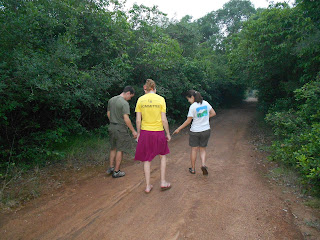India experiences a wide range of water issues, each of which are unique to the region and communities being studied. Estuaries and wetlands in India are highly impacted by human activity. In an estuary constant mixing of fresh and marine water occurs; therefore plants and animals that live in these waters have adapted to a euryhaline environment, where salt is present in up to 35 parts per million concentrations. Wetlands include any inland water body where water is spread over a large area. In India, estuaries and wetlands exist as a valuable resource to communities, and are used as such, but such water sources are also abused and polluted by the people living around them.
Estuaries and wetlands can be a good source of food and potable water. The main use of this land is for agriculture resulting in the common placement of paddy fields close to these water bodies if the species of rice has adapted to that environment. However, for all their usefulness, these water bodies also can become dumping grounds for local people. When solid waste is dumped into estuaries or wetlands, the waste accumulates and depth of the water decreases and the area of the wetlands shrinks until the region becomes like solid land. Eventually buildings are constructed on these former water bodies, which attracts migrant workers who continue to contribute to the trash dumped in the water, further reducing the area covered by the water body. The proximity to water becomes an attraction to settlers, but is detrimental to the water body because there are more people present to dump waste into the water.
Biologically, the pollution of water bodies has an adverse effect on the plant and animal life in the ecosystem. The banks of estuaries, wetlands, and other water bodies tend to attract various industrial companies because many industrial processes require copious amounts of water. The proximity of a water body also provides a convenient place to dispose of industrial waste. Thermal effluents from a power station can reach a temperature of 48 to 50°C. Such temperatures can kill even the plankton in the water, preventing primary productivity. A reduction in primary productivity can affect the entire ecosystem because other species depend on the plankton. Finally industrial pollution of water bodies can result in health-related issues such as skin and gynecological problems for people who consume contaminated water.
The effluents released by these industries contain toxic materials and heavy metals which can accumulate within aquatic plants and animals. Biomagnification of these toxins can occur as smaller organisms that consume the toxins are eaten by larger organisms, which accumulate higher levels of the toxic material. The loss of plants and animals due to pollution can be mitigated through the introduction of metallophilic plants, which accumulate and store heavy metals through a process called bioremediation
The presence of elemental contaminants also reduces the quality of drinking water for humans. In India, arsenic and fluoride are the major elements that pollute potable water. These usually come from a geogenic source and are not the result of human actions. Arsenic is a major issue in northeast India and results in skin, cardiovascular, circulatory, and respiratory illnesses, in addition to kidney and liver disease. The presence of fluoride in water results in human health issues like dental and skeletal fluorosis. Arsenic and fluoride can both be removed using proper filters, but the removal of these elements can be difficult owing to issues involved with disposal of the used filters and unwillingness of the people to use the filters.
Other contaminants include iron, which has both natural and anthropogenic sources, and nitrate, which comes from fertilizer use. With the increased use of agrochemicals and fertilizers, nitrate contamination of shallow aquifers has increased. The Cauvery river basin of South India is known as the “rice bowl” of India and this area suffers from a lot of nitrate contamination. Increased presence of nitrates in the drinking water can result in serious health problems.
Although India protects water bodies through the Pollution Control Board (PCB), there is no management or political will to enforce such regulations. Non-governmental organizations (NGOs) also contribute to efforts to regulate pollution of water bodies. However, without help from the government and support from the community, these organizations are only most effective at spreading awareness, and less effective at truly ending pollution. In order to effect real change in Indian communities’ treatment of water bodies, the government will need to ensure that implementation of policy is carried out to the fullest extent. This will require that the government involve the people in the formulation and execution of policy.










